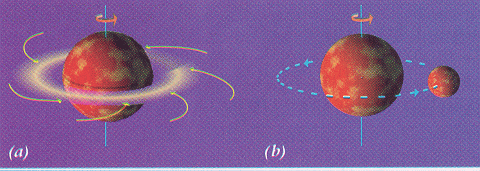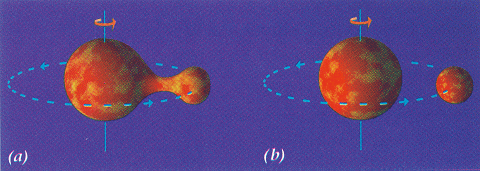The Formation of the Moon
Question: What properties should
any lunar formation theory be able to explain?
Competing Theories:
-
Capture - The Earth captures
a moon adrift in space
-
Pros: well, it's not
impossible
-
Cons:
-
it's very unlikely
-
kinetic energy must be carried away by a 3rd body
-
Accretion - The Earth
accretes planetesimals in early solar system to form Moon.

-
Pros: Lots of material
around in the early solar system to accrete
-
Cons:
-
Why would the Earth and Moon have different compositions
(ie why is the moon deficient in Iron)?
-
Earth-Moon system has too much angular momentum compared
to other planets.
-
Fission - A fast spinning
Earth "calves" the Moon.

-
Pros: Density of Moon
similar to that of the outer layers of the Earth
-
Cons:
-
Moon should be orbiting along Earth's equator; it's not.
-
Composition of Moon rocks dissimilar to that of the Earth's
surface.
-
Earth would have to have been spinning extremely fast (HW
problem).
-
Impact - A large planetesimal
hits Earth, ejecting material which forms the Moon
-
Pros:
-
Collisions happen (but this is a whopper: Mars sized or bigger!)
-
Explains lack of volatiles in Moon
-
Explains lack of an Iron core
-
Simulations confirm the possibility
Animation
-
Bonus: explains tip of the Earth's
axis!
-
Cons:
-
To get material past the Earth's Roche limit, the impactor
needs more angular momentum than is now in the Earth-Moon system.
-
Why just one moon?
Currently, the Impact theory is the most favored. But questions
remain, and work is ongoing...

